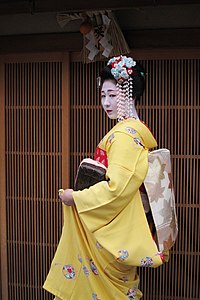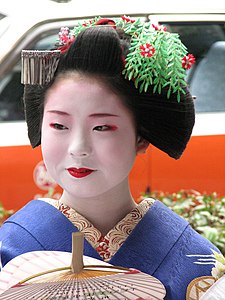Maiko
This article needs additional citations for verification. (May 2022) |

A maiko (舞妓, IPA: /ˈmaɪkoʊ/ MY-koh, Japanese: [maiko]) is an apprentice geisha in Kyoto and Western Japan[citation needed].[1] Their jobs consist of performing songs, dances, and playing the shamisen or other traditional Japanese instruments for visitors during banquets and parties, known as ozashiki.
Maiko are usually aged between 17 to 20 years old, and graduate to geisha status after a period of training, which includes learning traditional dance, learning to play the shamisen, learning to sing kouta (lit. 'short songs'), and, in Kyoto only, learning the Kyoto dialect. This apprenticeship usually ranges from a period of a few months to a year or two years, though apprentices too old to dress as maiko may instead skip to the stage of geisha, despite still being in training.
Apprentice geisha in other locations in Japan are known by other terms, such as hangyoku (半玉, lit. 'half jewel', referring to one term for a geisha's wages, "jewel money") for apprentices in Tokyo. The traditions of apprentice geisha in these areas vary from those in Kyoto, sometimes to a considerable degree, including an apprentice's appearance and the structure of their apprenticeship.
Work
In the morning, maiko take lessons in the traditional arts. At night, they go out to work. They dance, sing, play the shamisen, and serve visitors at exclusive ochaya (teahouses).
Origin
Maiko originated from women who served green tea and dango (Japanese dumpling made from rice flour) to people who visited the Kitano Tenman-gū or Yasaka Shrine in teahouses in Kyoto roughly 300 years ago.
Appearance
Hair
During their career, maiko will wear different kinds of nihongami (traditional Japanese hairstyles) depending on rank, formality and occasion. These hairstyles are then decorated with seasonal and occasional kanzashi (traditional hair ornaments).
Most maiko, unlike geisha, use their own hair with the addition of extensions, though apprentices in different areas of Japan may also use wigs. Maiko using their own hair have their hair restyled every week, meaning they must sleep on a special pillow known as a takamakura – a raised wooden block with a pillow – in order to maintain it.
Kimono and outfit
Hikizuri
Most maiko also wear a style of kimono known as a hikizuri (引きずり, lit. 'trailing skirt'). Hikizuri are typically anywhere from 200–240 centimetres (79–94 in) long, and often feature a lightly-padded hem to create weight allowing the skirt to trail along the floor. When walking outside, maiko hold their hikizuri up either with their hands, or by tying it in place with a small cord so that it does not drag along the ground. The style of hikizuri worn by most maiko features long, furisode-style sleeves, and may feature tucks sewn horizontally into the sleeves and vertically along the shoulders; this is a holdover from before WWII, when maiko often began their training at a young age, and would thus have the tucks taken out as they grew.
For formal occasions, maiko wear a black, kurotomesode-style hikizuri featuring 5 crests (kamon) to signify the okiya they belong to.
Darari obi
Maiko wearing hikizuri kimono typically wear it with an obi known as a darari obi (だらり帯, lit. 'dangling obi'). The darari obi is 6–7 metres (20–23 ft) long, is roughly 30 centimetres (12 in) wide, and is worn exclusively by maiko. Due to its length and weight, a male dresser (known as an otokoshi) is needed to tie it; otokoshi can dress a maiko in as little as five minutes, and may dress a number of maiko each night. The crest of a maiko's okiya is either dyed, embroidered or woven onto the end of the obi, below the kaikiri (end lines). For formal occasions, gold brocade darari obi are worn.
Kimono
Some maiko outside of Kyoto, and in particular in Tokyo, wear furisode instead of hikizuri; these apprentices (sometimes known as hangyoku) may also wear a wig instead of having their own hair styled.
Obi
Maiko outside of Kyoto may also wear a fukuro obi instead of a darari obi, which is easier to tie and wear; apprentices in Tokyo typically tie their obi in the fukura suzume style.
Gallery
-
Two Kyoto maiko walking
-
Minarai wearing shidare kanzashi, composed by long chains of silk flowers
-
Maiko with willow kanzashi
-
(video) A maiko dancing
References
- ^ "Definition of maiko | Dictionary.com". www.dictionary.com. Retrieved 2022-05-16.



